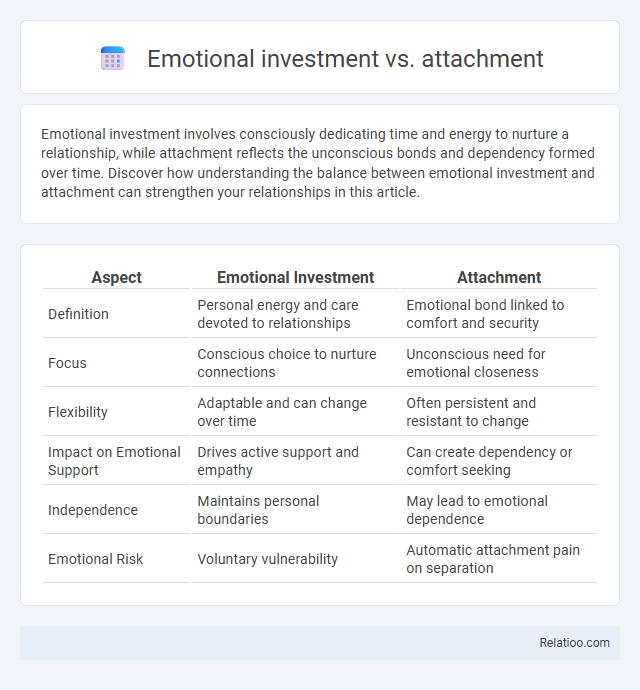Emotional investment involves consciously dedicating time and energy to nurture a relationship, while attachment reflects the unconscious bonds and dependency formed over time. Discover how understanding the balance between emotional investment and attachment can strengthen your relationships in this article.
Table of Comparison
| Aspect | Emotional Investment | Attachment |
|---|---|---|
| Definition | Personal energy and care devoted to relationships | Emotional bond linked to comfort and security |
| Focus | Conscious choice to nurture connections | Unconscious need for emotional closeness |
| Flexibility | Adaptable and can change over time | Often persistent and resistant to change |
| Impact on Emotional Support | Drives active support and empathy | Can create dependency or comfort seeking |
| Independence | Maintains personal boundaries | May lead to emotional dependence |
| Emotional Risk | Voluntary vulnerability | Automatic attachment pain on separation |
Understanding Emotional Investment
Emotional investment involves dedicating your feelings and energy into a person or relationship with the expectation of meaningful returns, while attachment often reflects a deep-seated bond influenced by familiarity and comfort. Understanding emotional investment requires recognizing the active role you play in nurturing connections, as it directly impacts your emotional well-being and relationship dynamics. Prioritizing healthy emotional investment helps differentiate between supportive bonds and potentially codependent attachments.
Defining Attachment in Relationships
Attachment in relationships refers to the deep emotional bond that develops between individuals, characterized by feelings of security, trust, and a desire for closeness. Unlike emotional investment, which involves time and energy spent nurturing the relationship, attachment centers on an innate psychological connection that influences behavior and emotional responses. Understanding attachment styles helps clarify how people form and maintain long-term bonds, impacting relationship satisfaction and stability.
Key Differences Between Emotional Investment and Attachment
Emotional investment involves actively committing feelings and energy toward a person, goal, or relationship, often based on trust and expectations of positive outcomes, whereas attachment is a deeper, often unconscious emotional bond characterized by dependency and the need for security. Key differences include that emotional investment is a purposeful, conscious process influencing motivation and decision-making, while attachment reflects automatic emotional responses shaped by early experiences and emotional needs. Understanding these distinctions helps clarify how emotional dynamics affect relationship quality and individual well-being.
Signs of Healthy Emotional Investment
Healthy emotional investment is characterized by consistent communication, mutual respect, and balanced effort between partners, fostering trust and emotional security. Signs include open vulnerability, emotional responsiveness, and a willingness to support each other's growth without dependency. Unlike unhealthy attachment, which may involve clinginess or control, healthy emotional investment promotes autonomy and resilience within the relationship.
Indicators of Unhealthy Attachment
Indicators of unhealthy attachment include persistent anxiety when separated from a person, excessive dependence on their approval, and difficulty maintaining personal boundaries. Emotional investment that leads to neglecting self-care or sacrificing personal values signals a problematic attachment pattern. Behavioral signs, such as jealousy, controlling tendencies, and intrusive thoughts, often reveal an emotionally unhealthy bond.
Emotional Investment: Benefits and Risks
Emotional investment involves dedicating significant feelings and energy toward a person, goal, or project, fostering deep motivation and stronger relationships. The benefits include increased resilience, enhanced satisfaction, and greater personal growth through meaningful connections or achievements. However, risks such as emotional burnout, vulnerability to disappointment, and difficulty detaching can lead to stress and hinder decision-making.
Attachment Styles and Their Impact
Attachment styles--secure, anxious, avoidant, and disorganized--play a crucial role in shaping your emotional investment and attachment patterns. Secure attachment fosters healthy emotional connections, while anxious and avoidant styles often lead to inconsistent emotional investment and difficulty forming stable bonds. Understanding these styles helps you navigate relationships more effectively by recognizing how early attachment experiences influence your current emotional involvement.
How Emotional Investment Influences Behavior
Emotional investment deeply impacts your behavior by driving commitment, decision-making, and reactions to situations involving people or goals. Unlike mere attachment, emotional investment involves a conscious choice to engage and sustain effort, which can lead to stronger motivation and resilience. This heightened emotional engagement often results in more consistent actions and a greater sense of responsibility toward the object of your investment.
Managing Attachment for Balanced Relationships
Managing attachment is crucial for balanced relationships, as excessive emotional investment can lead to dependency and imbalance. Your emotional well-being improves when you set healthy boundaries, fostering secure attachment rather than anxious or avoidant patterns. Understanding the difference between emotional investment and attachment helps maintain connection without losing individuality or becoming overly reliant.
Building Healthy Emotional Connections
Emotional investment involves actively committing feelings and energy into relationships to foster trust and understanding, whereas attachment often refers to the instinctual bonds formed for security and comfort. Building healthy emotional connections requires balancing emotional investment without becoming overly attached, which can lead to dependency or imbalance. Fostering clear communication, setting boundaries, and encouraging mutual respect are key elements in developing relationships that promote well-being and emotional growth.

Infographic: Emotional investment vs Attachment
 relatioo.com
relatioo.com